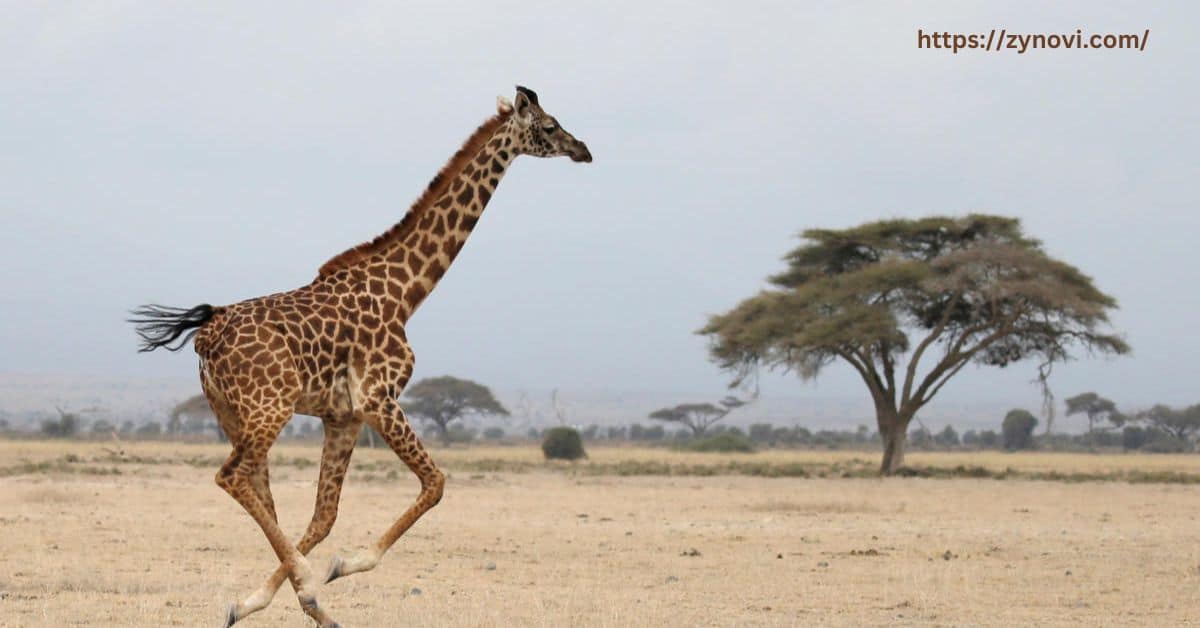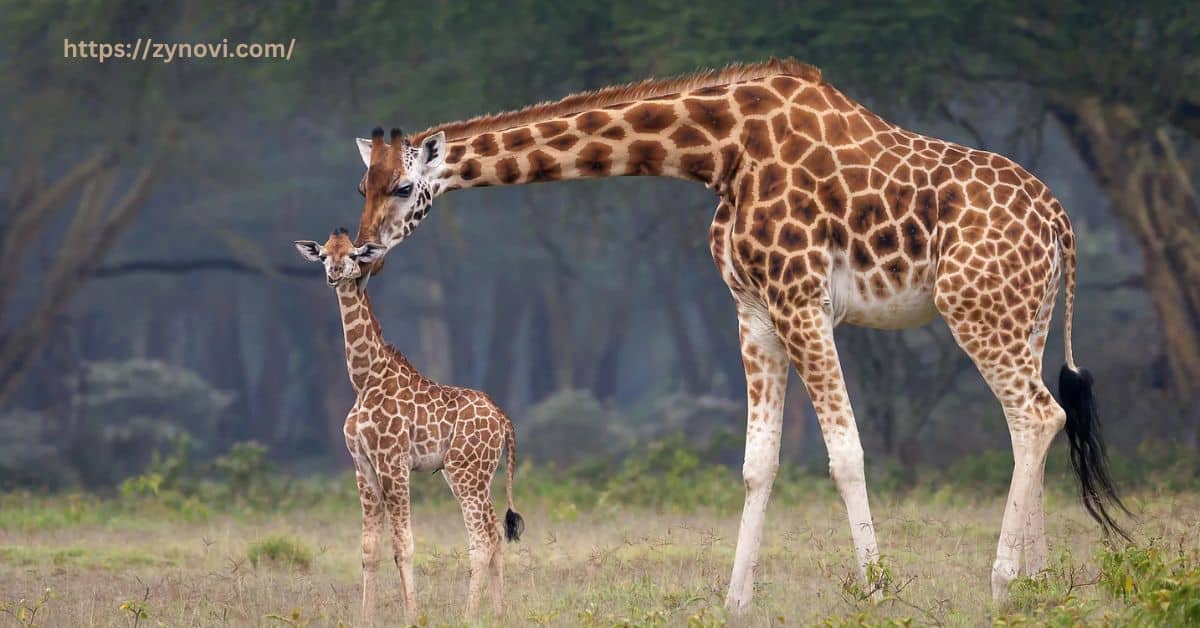Do Giraffes Attack Humans? Giraffes are peaceful animal, and they rarely attack humans, it is usually due to feeling threatened or provoked.
You may be surprised to learn that despite their towering height and peaceful appearance, giraffes can indeed become aggressive under certain circumstances. While these majestic animals are typically known for their calm demeanor, it’s important to understand what might push them to act in defense.
In this article, we’ll explore the truth behind giraffe behavior. How they protect themselves and their young, and whether or not you need to worry about encountering one in the wild. Keep reading to uncover the surprising facts and stay safe on your next safari!
Understand What Are Giraffes?
Physical Characteristics
Giraffes (Giraffa camelopardalis) are the tallest land animals, with their towering height, elegant strides, and iconic long necks, are among the most fascinating creatures of the African savanna.
Often regarded as peaceful, non-confrontational animals, these giants rarely exhibit aggressive tendencies.
| Attribute | Details |
|---|---|
| Height | Males: Up to 18 feet; Females: 14-16 feet |
| Neck Structure | Seven elongated vertebrae, enabling them to reach treetop foliage, their primary food source |
| Weight | 1,800-3,000 pounds |
| Powerful Legs | Capable of delivering a deadly kick that can shatter a lion’s skull or break bones |
| Ossicones | Horn-like structures on their heads, covered in skin, used in dominance displays |
| Speed and Stamina | Can run at up to 35 miles per hour over short distances to escape predators |
Habitat and Range
Giraffes are native to the African savanna, thriving in vast open woodlands and grasslands that provide abundant food sources and visibility. They are commonly found in wildlife reserves, safari parks, and national parks across the continent.
Their keen eyesight allows them to detect predators like lions, leopards, and hyenas from afar, making them well-adapted to their natural habitat.
Behavioral Traits
Giraffes are typically calm and non-confrontational, spending most of their time foraging on treetop foliage. However, their behavior undergoes a significant shift when they perceive danger or need to protect their young.
In such situations, giraffes display remarkable defensive behaviors, including powerful kicks and defensive postures. Their maternal instincts, in particular, drive fierce protectiveness, ensuring the safety of their vulnerable calves.
Do Giraffes Attack Humans?

While giraffes are not naturally aggressive, specific situations can provoke them to act defensively.
Understanding Giraffe Temperament
Giraffes are renowned for their peaceful demeanor and typically prefer a flight over fight response when faced with potential threats. Their calm nature, however, can quickly change under specific circumstances.
Feeling cornered, sensing danger to their calves, or encountering sudden disturbances can trigger aggressive behaviors. In such instances, giraffes rely on their formidable strength and defensive instincts to confront perceived threats.
When Giraffes Feel Threatened
When giraffes feel threatened, their imposing size and strength provide a sense of confidence, but they don’t hesitate to defend themselves when necessary:
- Defensive Posture: Giraffes often respond by widening their stance and fixating their keen eyesight on the intruder, signaling their awareness and readiness.
- Lashing Out: If danger intensifies, they strike with powerful, swift kicks in multiple directions. These kicks are strong enough to shatter bones or incapacitate predators like lions or hyenas.
The Power of Maternal Instincts: Protecting Their Young
Calves are particularly vulnerable to predators such as lions, leopards, and hyenas, making mother giraffes fiercely protective. A mother giraffe will use her size and kicking strength to shield her offspring, often deterring even the most persistent predators.
Types of Giraffe Attacks
- Kicking: Giraffes deliver exceptionally powerful kicks with their long, muscular legs. These strikes can cause severe injuries, fractures, or even death to predators like lions, leopards, or hyenas when defending themselves or their young.
- Headbutting: Though rare, giraffes use headbutts during necking contests or to establish dominance. The ossicones on their heads enhance the impact, making these strikes potentially dangerous.
- Neck Swings: Giraffes use their long necks as a formidable weapon, swinging them forcefully against rivals or threats. This behavior is often seen during conflicts over mates or territory.
How Common Are Giraffe Attacks ?
Do Giraffes Attack Humans? Encounters between giraffes and humans are generally peaceful, as giraffes are non-confrontational animals by nature.
Documented cases of attacks on humans are extremely rare and often occur when the giraffe feels provoked, cornered, or startled.
Such incidents are usually accidental, resulting from humans venturing too close, disrupting their space, or misinterpreting the giraffe’s defensive behaviors.
Giraffe Defensive Behavior

Giraffes employ several defensive mechanisms to protect themselves:
- Kicking as a Defense Mechanism: Giraffes are capable of delivering powerful kicks with their hind legs. These kicks are strong enough to break bones or even kill predators such as lions or hyenas, making them an effective means of self-defense.
- Neck Swings: While primarily used in dominance battles during “necking” contests, giraffes can also swing their long necks at perceived threats. These swings are forceful and can strike with significant impact.
- Standing Their Ground: When faced with danger, giraffes may stomp their feet or hold their position, using their towering size and intense stare to intimidate potential predators and defend their space.
Situations That Trigger Defensive Behavior
- Predatory Threats: Giraffes, despite their calm nature, become fiercely defensive when confronted by predators such as lions, hyenas, or other threats. Their powerful kicks and neck swings are often their first line of defense to protect themselves and their calves.
- Human Interference: Accidental encounters, especially during safaris or in zoos, can trigger defensive reactions from giraffes. If humans get too close or startle them, giraffes may resort to stomping, kicking, or adopting a defensive posture to protect their space.
Are Giraffes Dangerous to Humans in Zoos?
Giraffe Behavior in Captivity
In captivity, such as in zoos or wildlife reserves, giraffes adapt to their controlled environment but still retain their natural instincts. While they generally remain calm and docile, they may exhibit defensive behaviors if they feel cornered or threatened.
Giraffes require ample space to roam, and as long as their territory is respected, they tend to maintain a peaceful demeanor. However, disruptions or sudden movements can trigger their defensive mechanisms.
Safety Measures in Zoos
- Maintain a Safe Distance:
- Zoos ensure the safety of both visitors and giraffes by setting up barriers or enclosures that prevent close contact. These measures help avoid unexpected interactions that could stress the animals or provoke defensive behaviors.
- Recognizing Warning Signs:
- Giraffe body language is a crucial indicator of their mood. Zookeepers and visitors are trained to identify signs such as widened stance, ear positioning, or head lowering, which may signal that the giraffe feels threatened and is preparing to defend itself.
- Training Protocols:
- Zookeepers undergo special training protocols to handle giraffes with care, focusing on minimizing stress for the animals. By working with giraffes in a calm and controlled manner, they reduce the likelihood of triggering aggressive or defensive actions.
Rare Zoo-Related Incidents
- Although extremely rare, there have been instances where giraffes in zoos have displayed aggression, usually triggered by perceived threats or improper handling.
- These situations typically occur when the giraffe feels cornered, stressed, or is provoked by sudden movements or unfamiliar actions.
- Such incidents highlight the importance of proper training for zookeepers and maintaining a safe, respectful environment to prevent any disruptions to the giraffes’ natural calm demeanor.
Coexisting Safely with Giraffes

Best Practices for Wildlife Enthusiasts
- Respect Their Space: During safaris, always maintain a safe distance and avoid approaching giraffes too closely to prevent causing stress or triggering defensive behavior.
- Avoid Sudden Movements: Giraffes can be startled easily, so move slowly and calmly to avoid alarming them, especially when in close proximity.
- Recognize Warning Signs: Be aware of defensive postures or agitation, such as a giraffe widening its stance or swinging its neck, signaling that it may feel threatened and needs space.
Role of Conservation Efforts
Conservation plays a crucial role in protecting giraffes while ensuring that human interactions remain safe.
Initiatives like anti-poaching measures and habitat preservation contribute to the well-being of these majestic creatures.
FAQs
Can giraffes be friendly to humans?
Giraffes are generally peaceful and non-confrontational, but they do not form close bonds with humans like domesticated animals.
Can a human outrun a giraffe?
No, giraffes can run at speeds of up to 35 miles per hour, far faster than any human can sprint.
Can a human walk under a giraffe?
It’s unlikely; even though giraffes have long necks, their height typically ranges from 14 to 18 feet, making it difficult to walk directly under them.
Are giraffes scared of humans?
Giraffes are generally not afraid of humans but may become cautious or defensive if they feel threatened or cornered.
Conclusion: Do Giraffes Attack Humans?
Giraffes are generally non-confrontational animals, but their formidable weapons powerful legs, towering height, and kicking strength make them capable of defending themselves against perceived threats. Human-giraffe interactions are overwhelmingly peaceful, but respecting their space and understanding their behavior is essential for coexistence.
Whether you’re observing them in the African savanna, on a safari, or at a zoo, these gentle giants remind us of nature’s delicate balance between beauty and strength. Always maintain a safe distance and admire their magnificence from afar.










